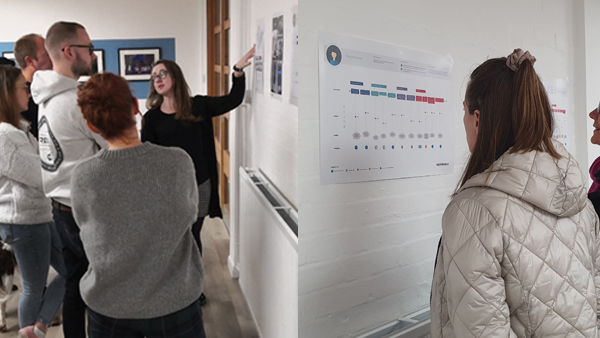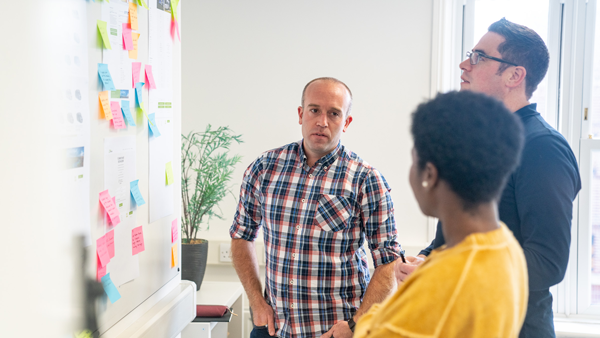How’s your UX momentum? Like painting the Forth bridge, improving experience is a never-ending task. The uphill struggle to improve user experience across multiple systems, stakeholders and silos feels unending… impossible?
Transforming your users’ experience is entirely possible and attainable. Challenging? Yes. Impossible? No. Momentum builds with each next step.
In one half of the organisation, there’s a good amount of momentum. In the other, there’s very little momentum or understanding.
….said one Insider Insights respondent. The need for and value of user research and UX momentum has never been greater. The Experience UX team downed tools to capture 15 ways you can build UX momentum in your organisation. Actionable, low cost, low bar, and low effort steps for a high reward which you can take today:
- Hot desk. Hot desk next to your customer service colleagues once a week. Get to know them, seek permission to be around their team and conversations to comprehend frequently tackled customer challenges. Show them how being the voice of their customers can result in improved UX and save them time and effort!
- Host a mini-museum. Take over a wall in a corridor and communicate what users experiencing. Share the story your research and qualitative data is communicating. Share how UX is bringing about meaningful change for your users and your organisation by hosting a mini-museum.

- Talk to a user. This may sound obvious, but when was the last time you talked to a user of your products and services? Stick a recurring appointment in your calendar to pick up the phone to a new customer – ask them open questions about their experience. Dare your seniors to do likewise. Set them up on user-blind dates.
- Gift your colleagues a present. There’s nothing like Alan Cooper’s book, The Inmates are Running the Asylum to equip your team with user-centred thinking and feeling. Cooper’s book is particularly helpful for developers, as it’s written by a developer, to developers.
- Find your allies. Who within your organisation gets what it truly means to be user-centred? Do you have an outstanding customer service colleague who goes above and beyond to spot and resolve customer issues? Do you have an ally in the board room or management? Seek them out; connect and work with them to form a user-centred task force, each advocating in their respective spheres.
- Switch off your computer. Go to where your users are. Watch them, listen to them, be curious about them. That may mean sitting next to and shadowing a colleague for a day. It might mean seeking out willing users or customers to share their experience with you in exchange for a coffee.
- Profile your profiles. Don’t let your user profiles get dusty. It’s so easy for them to gather dust in digital filing cabinets. Print them and place them front and centre in your office or workspace. Bring them to meetings you attend. One client we work with had the genius idea of printing flipbooks with which they equip their team. If you don’t have user profiles, create them. Even if only at a high level. Read Alan Cooper’s chapter (see #4) on personas to get started.
- Collect qualitative data. Users’ good, bad, and ugly experiences are likely to be shared with your colleagues every day through words, statements, and conversations. How can you open your eyes and ears to look for; hear, and record the words of your users? Continually flag them to your colleagues in meetings, Slack channels, and break room conversations. Are you sitting on any untapped sources of qualitative data?
- Highlight an unknown. Take notice of stats, statements, and gut feelings, and ask yourself if you’ve just encountered an unknown? Dig deep and shine a spotlight on it with your team. Perhaps a colleague presents their theory as to why only 30 per cent of users complete this form – dare them to find out the why behind that what. Show them how talking to users will source true clues to the answer the unknowns.
- Get to the whiteboard. Grappling with a new product, feature, or service? Lots of ideas, hot air but not much action? Stop. Pause. Gather your colleagues at a whiteboard. Guide them to place themselves in the shoes of a user and ask them the questions; ‘Why is/isn’t our customer using this feature? What are they trying to achieve? What is their most ideal journey to complete their task?’

- Challenge assumptions. Once you become alert to them, you’ll see that they’re everywhere. They usually come after a ‘they won’t…,’ or ‘they will…’, or ‘we know that…’. There’ll likely be an assumption close behind. Gently challenge the holder of that assumption.
- Complete a guerrilla usability test. Are you wrestling with a challenge? Have you just created a new feature? When did you last observe someone using your website or app? Phone a friend, pull in a favour with a family member or invite a colleague with fresh eyes to a short guerrilla usability test. Set them a scenario and task; sit back and observe how they get on. Resist the temptation to offer any help or prompts.
- Host a usability premiere. Bribe a group of colleagues with popcorn, chocolate, and cake to attend the screening of a usability test. Dim the lights, show it on a big display, have post-it notes to hand. Spark conversation and debate throughout the session. Do this once a month to keep placing your users front and centre. Bonus points for each senior manager you convince to join.
- Show and share. Share an open invite to colleagues through all areas of your organisation to a half-hour show and share how your work is changing users’ experiences. Make it a regular occurrence in the calendar.
- Listen to your intuition. It’s always there, always guiding you. Listen to it. Tap into it. Trust it. Learn to take time to notice how it’s guiding you. There’s a reason why we have some of our best ideas whilst in the shower, during exercise or on a commute: make space in your day to switch off your notifications and notice what you notice.
Climbing the mountain of user experience transformation starts with placing one foot in front of the other. Your users’ experience is at stake. Start today.

